当前位置:网站首页>The fledgling Xiao Li's 112th blog project notes: Wisdom cloud intelligent flower watering device actual combat (1) - basic Demo implementation
The fledgling Xiao Li's 112th blog project notes: Wisdom cloud intelligent flower watering device actual combat (1) - basic Demo implementation
2022-08-01 02:05:00 【fledgling li】
项目文件夹框架

- API文件夹---------------------------------------Place various sensor driver code folders
- CMSIS文件夹----------------------------------Place the kernel support files folder
- JIZHIYUN文件夹------------------------------Place the Gizwits platform docking file folder
- PROJECT文件夹------------------------------Put the project directory folder
- STARTUP文件夹------------------------------Put the startup code folder
- STM32F10x_StdPeriph_Driver文件夹—Place the standard library functions folder
- USER文件夹-----------------------------------A folder where some files necessary for the project are placed
核心板原理图
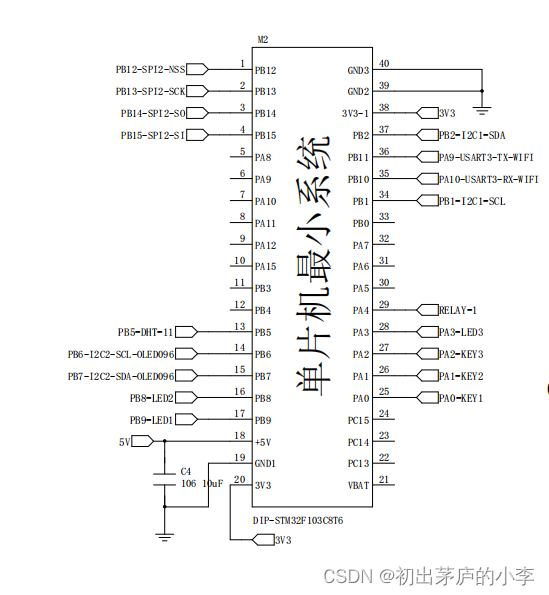
LED灯的驱动代码编写
原理图
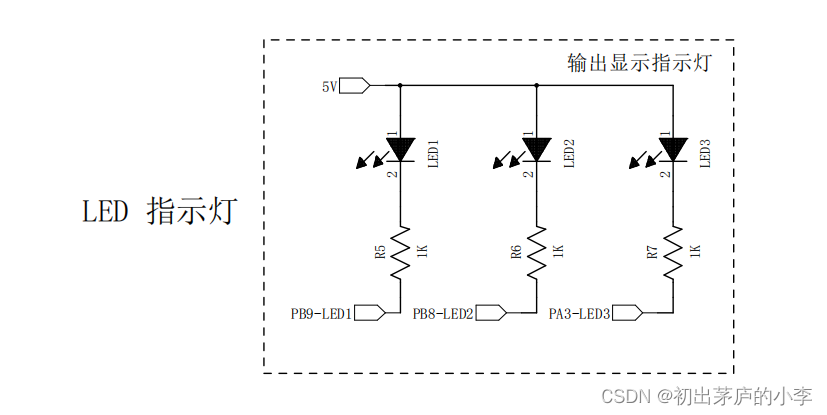
代码实现
#include "led.h"
#include "systick.h"
void LED_Init(void)
{
RCC_APB2PeriphClockCmd(LED1_CLK, ENABLE);
RCC_APB2PeriphClockCmd(LED2_CLK, ENABLE);
RCC_APB2PeriphClockCmd(LED3_CLK, ENABLE);
GPIO_InitTypeDef LED_InitStruct = {
0};
LED_InitStruct.GPIO_Pin = LED1_PIN;
LED_InitStruct.GPIO_Mode = GPIO_Mode_Out_PP;
LED_InitStruct.GPIO_Speed = GPIO_Speed_50MHz;
GPIO_Init(LED1_PORT, &LED_InitStruct);
LED_InitStruct.GPIO_Pin = LED2_PIN;
GPIO_Init(LED2_PORT, &LED_InitStruct);
LED_InitStruct.GPIO_Pin = LED3_PIN;
GPIO_Init(LED3_PORT, &LED_InitStruct);
LED1(0);
LED2(0);
LED3(0);
}
void LED_Task(void)
{
static uint32_t Timer = 0;
static uint8_t Sta = 0;
if(SoftTimer(Timer,500))
{
Timer=GetSoftTimer();
Sta?(Sta=0):(Sta=1);
LED1(Sta);
LED2(Sta);
LED3(Sta);
}
}
void GPIO_TogglePin(GPIO_TypeDef* GPIOx, uint16_t GPIO_Pin)
{
uint32_t ODR;
ODR = GPIOx->ODR;
GPIOx->BSRR = ((ODR & GPIO_Pin) << 16U) | (~ODR & GPIO_Pin);
}
#ifndef __LED_H_
#define __LED_H_
#include "stm32f10x.h"
//PB9 --- LED1 --- 低有效
//PB8 --- LED2 --- 低有效
//PA3 --- LED3 --- 低有效
//基于STM32标准库 芯片是 STM32F103C8T6
#define LED1_CLK RCC_APB2Periph_GPIOB
#define LED1_PORT GPIOB
#define LED1_PIN GPIO_Pin_9
#define LED2_CLK RCC_APB2Periph_GPIOB
#define LED2_PORT GPIOB
#define LED2_PIN GPIO_Pin_8
#define LED3_CLK RCC_APB2Periph_GPIOA
#define LED3_PORT GPIOA
#define LED3_PIN GPIO_Pin_3
//宏定义的一个开关
#define LED1(X) X?(GPIO_ResetBits(LED1_PORT,LED1_PIN)):(GPIO_SetBits(LED1_PORT,LED1_PIN))
#define LED2(X) X?(GPIO_ResetBits(LED2_PORT,LED2_PIN)):(GPIO_SetBits(LED2_PORT,LED2_PIN))
#define LED3(X) X?(GPIO_ResetBits(LED3_PORT,LED3_PIN)):(GPIO_SetBits(LED3_PORT,LED3_PIN))
void LED_Init(void);
void GPIO_TogglePin(GPIO_TypeDef* GPIOx, uint16_t GPIO_Pin);
void LED_Task(void);
#endif
按键驱动的代码编写
原理图
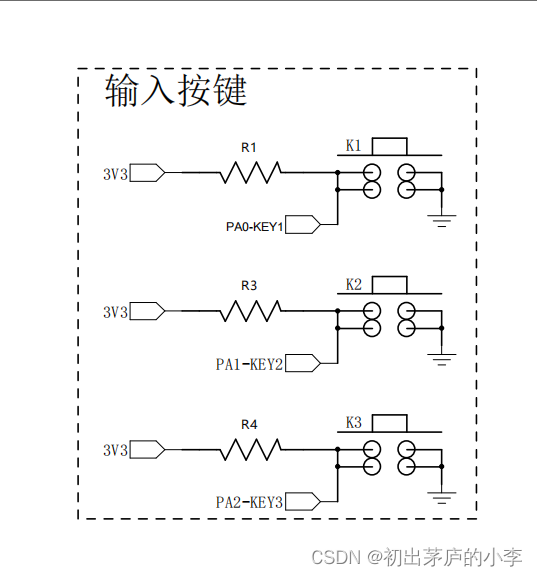
代码实现
#include "key.h"
#include "systick.h"
void KEY_Init(void)
{
RCC_APB2PeriphClockCmd(KEY0_CLK,ENABLE);
RCC_APB2PeriphClockCmd(KEY1_CLK,ENABLE);
RCC_APB2PeriphClockCmd(KEY2_CLK,ENABLE);
GPIO_InitTypeDef KEY_InitStruct;
KEY_InitStruct.GPIO_Pin = KEY0_PIN|KEY1_PIN|KEY2_PIN;
KEY_InitStruct.GPIO_Mode = GPIO_Mode_IPU;
KEY_InitStruct.GPIO_Speed = GPIO_Speed_50MHz;
GPIO_Init(KEY0_PORT ,&KEY_InitStruct);
GPIO_Init(KEY1_PORT ,&KEY_InitStruct);
GPIO_Init(KEY2_PORT ,&KEY_InitStruct);
}
static uint8_t Key0Value=0;
static uint8_t Key1Value=0;
static uint8_t Key2Value=0;
void KeyScan(void)
{
static uint16_t Key0Timer=0;
static uint16_t Key1Timer=0;
static uint16_t Key2Timer=0;
if(KEY0==0)
{
if(Key0Timer<10)
{
Key0Timer++;
if(Key0Timer>=10)
Key0Value=1;
}
}
else
{
Key0Timer = 0;
}
if(KEY1==0)
{
if(Key1Timer<10)
{
Key1Timer++;
if(Key1Timer>=10)
Key1Value=1;
}
}
else
{
Key1Timer = 0;
}
if(KEY2==0)
{
if(Key2Timer<10)
{
Key2Timer++;
if(Key2Timer>=10)
Key2Value=1;
}
}
else
{
Key2Timer = 0;
}
}
uint8_t GetKey0(void)
{
uint8_t Key=Key0Value;
Key0Value=0;
return Key;
}
uint8_t GetKey1(void)
{
uint8_t Key=Key1Value;
Key1Value=0;
return Key;
}
uint8_t GetKey2(void)
{
uint8_t Key=Key2Value;
Key2Value=0;
return Key;
}
#ifndef __KEY_H_
#define __KEY_H_
#include "stm32f10x.h"
#define KEY0_CLK RCC_APB2Periph_GPIOA
#define KEY0_PORT GPIOA
#define KEY0_PIN GPIO_Pin_0
#define KEY1_CLK RCC_APB2Periph_GPIOA
#define KEY1_PORT GPIOA
#define KEY1_PIN GPIO_Pin_1
#define KEY2_CLK RCC_APB2Periph_GPIOA
#define KEY2_PORT GPIOA
#define KEY2_PIN GPIO_Pin_2
#define KEY0 GPIO_ReadInputDataBit(KEY0_PORT,KEY0_PIN)
#define KEY1 GPIO_ReadInputDataBit(KEY1_PORT,KEY1_PIN)
#define KEY2 GPIO_ReadInputDataBit(KEY2_PORT,KEY2_PIN)
void KEY_Init(void);
void KeyScan(void);
uint8_t GetKey0(void);
uint8_t GetKey1(void);
uint8_t GetKey2(void);
#endif
测试驱动程序的正确性
#include "main.h"
int main(void)
{
NVIC_PriorityGroupConfig(NVIC_PriorityGroup_2);
USART1_Init(9600);
//printf("打印串口初始化 OK !\r\n");
SysTick_Init();
//printf("系统嘀嗒初始化 OK !\r\n");
LED_Init();
//printf("状态指示初始化 OK !\r\n");
KEY_Init();
//printf("按键配置初始化 OK !\r\n");
while(1)
{
LED_Task();
if(GetKey0())
{
GPIO_TogglePin(LED1_PORT,LED1_PIN);
//JiaoHua(1-currentDataPoint.valueRelay_1);
}
if(GetKey1())
{
GPIO_TogglePin(LED2_PORT,LED2_PIN);
//gizwitsSetMode(WIFI_AIRLINK_MODE);
//按键进入配网模式
}
if(GetKey2())
{
GPIO_TogglePin(LED3_PORT,LED3_PIN);
}
}
}
其他辅助代码
串口打印实现
在开发板上用的是USB TO TTL 工具 串口1 打印 实际的项目板上没有设计该电路(失误1)
串口1 驱动代码
#include "usart1.h"
#include <stdio.h>
void USART1_NVIC_Config(void)
{
//接收中断使能
NVIC_InitTypeDef NVIC_InitStruct;
/*NVIC控制器配置*/
NVIC_InitStruct.NVIC_IRQChannel = USART1_IRQn;//具体中断源名字
NVIC_InitStruct.NVIC_IRQChannelCmd = ENABLE;//NVIC响应通道使能
NVIC_InitStruct.NVIC_IRQChannelPreemptionPriority = 0;//抢占优先级值
NVIC_InitStruct.NVIC_IRQChannelSubPriority = 1;//响应优先级别值
NVIC_Init(&NVIC_InitStruct);
}
/*打印调试串口*/
void USART1_Init(uint32_t BaudRate)
{
USART_DeInit(USART1);
//1.打开GPIO的时钟
RCC_APB2PeriphClockCmd(RCC_APB2Periph_GPIOA,ENABLE);
//2.配置相关结构体
GPIO_InitTypeDef GPIO_InitStruct;
//串口发送引脚的配置 PA9->复用推挽输出
GPIO_InitStruct.GPIO_Pin = GPIO_Pin_9;
GPIO_InitStruct.GPIO_Mode = GPIO_Mode_AF_PP;
GPIO_InitStruct.GPIO_Speed = GPIO_Speed_50MHz;
GPIO_Init(GPIOA,&GPIO_InitStruct);
//串口接收引脚的配置 PA10->浮空输入模式
GPIO_InitStruct.GPIO_Pin = GPIO_Pin_10;
GPIO_InitStruct.GPIO_Mode = GPIO_Mode_IN_FLOATING;//浮空输入模式
GPIO_InitStruct.GPIO_Speed = GPIO_Speed_50MHz;
GPIO_Init(GPIOA,&GPIO_InitStruct);
//1.打开串口的时钟
RCC_APB2PeriphClockCmd(RCC_APB2Periph_USART1,ENABLE);//注意APB2
USART_InitTypeDef USART1_InitStruct;
//串口的参数配置 波特率可以更改
//无硬件流控制 收发模式
//1起始位 8数据位 无奇偶校验 1位停止位
USART1_InitStruct.USART_BaudRate = BaudRate;
USART1_InitStruct.USART_HardwareFlowControl = USART_HardwareFlowControl_None;
USART1_InitStruct.USART_Mode = USART_Mode_Rx|USART_Mode_Tx;
USART1_InitStruct.USART_Parity = USART_Parity_No;
USART1_InitStruct.USART_StopBits = USART_StopBits_1;
USART1_InitStruct.USART_WordLength = USART_WordLength_8b;
//串口1初始化
USART_Init(USART1,&USART1_InitStruct);
/**************************************************************/
//开串口中断
USART_ITConfig(USART1, USART_IT_RXNE, ENABLE);//接收中断
//USART_ITConfig(USART1, USART_IT_IDLE, ENABLE);//空闲中断
//中断优先级配置
USART1_NVIC_Config();
USART_Cmd(USART1,ENABLE);
}
/*串口重定向函数 目的是让STM32支持printf("%d %x %c ")*/
int fputc(int ch , FILE *stream)
{
while(USART_GetFlagStatus(USART1,USART_FLAG_TXE)==RESET);
USART_SendData(USART1,(uint16_t) ch); //数据通过串口发送
while(USART_GetFlagStatus(USART1,USART_FLAG_TC)==RESET);
return ch;
}
#ifndef __USART1_H_
#define __USART1_H_
#include "stm32f10x.h"
void USART1_Init(uint32_t BaudRate);
#endif
系统嘀嗒定时器代码
#include "systick.h"
#include "key.h"
uint32_t mySysTick_Config(uint32_t ticks)
{
if (ticks > SysTick_LOAD_RELOAD_Msk) return (1); /* Reload value impossible */
SysTick->LOAD = (ticks & SysTick_LOAD_RELOAD_Msk) - 1; /* set reload register */
NVIC_SetPriority (SysTick_IRQn, (1<<__NVIC_PRIO_BITS) - 1); /* set Priority for Cortex-M0 System Interrupts */
SysTick->VAL = 0; /* Load the SysTick Counter Value */
SysTick->CTRL = SysTick_CTRL_CLKSOURCE_Msk |
SysTick_CTRL_TICKINT_Msk |
SysTick_CTRL_ENABLE_Msk; /* Enable SysTick IRQ and SysTick Timer */
return (0); /* Function successful */
}
void SysTick_Init(void)
{
//SystemInit();
SysTick_CLKSourceConfig(SysTick_CLKSource_HCLK);
mySysTick_Config(SystemCoreClock/1000);
}
void SysTick_Handler(void)
{
SystemTick();
KeyScan();
}
static uint32_t Ticks=0;
void SystemTick(void)
{
Ticks++;
}
uint32_t GetSoftTimer(void)
{
return Ticks;
}
uint8_t SoftTimer(uint32_t BaseTimer,uint32_t Timeout)
{
if(Ticks>=BaseTimer)
return (Ticks)>=Timeout+BaseTimer;
return (Ticks+0xFFFFFF)>=Timeout+BaseTimer;
}
边栏推荐
猜你喜欢

元宇宙改变人类工作模式的四种方式
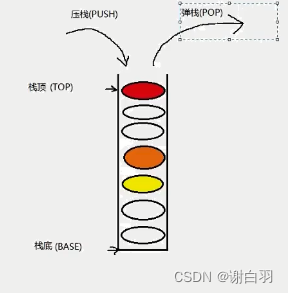
Game Security 03: A Simple Explanation of Buffer Overflow Attacks

leetcode:1648. 销售价值减少的颜色球【二分找边界】

ECCV2022 Workshop | Multi-Object Tracking and Segmentation in Complex Environments
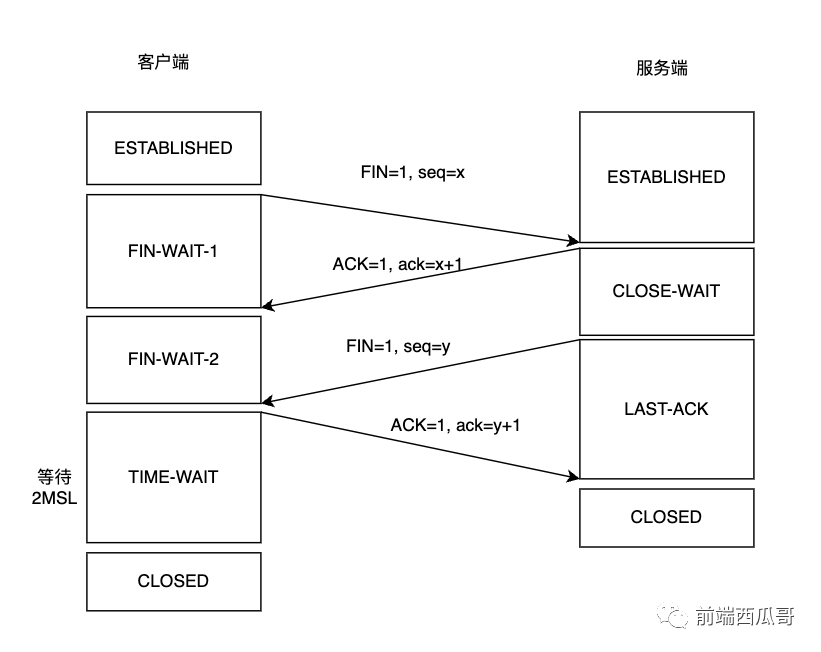
你需要知道的 TCP 四次挥手
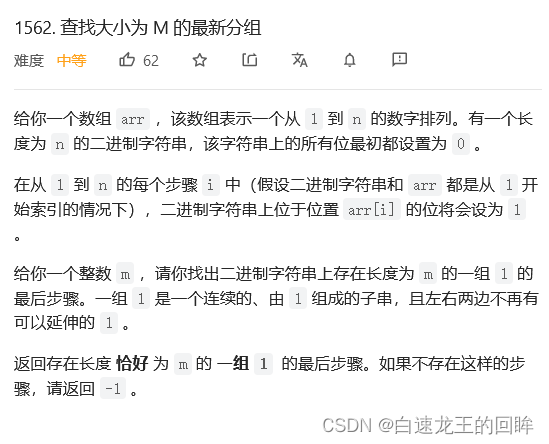
leetcode:1562. 查找大小为 M 的最新分组【模拟 + 端点记录 + 范围合并】

带wiringPi库在unbutu 编译 并且在树莓派运行

How is the tree structure of the device tree reflected?

HCIP(14)

how to edit the table of contents of an epub ebook
随机推荐
Summary of JVM interview questions (continuously updated)
HCIP(15)
gateway gateway cross domain
RTL8762DK PWM (seven)
Cmake introductory study notes
What is the meaning of JS timestamp?Know SQL will consider to add a timestamp, JS timestamp for the scene?
Js replication
初出茅庐的小李第114篇博客项目笔记之机智云智能浇花器实战(3)-基础Demo实现
[cellular automata] based on matlab interface aggregation cellular automata simulation [including Matlab source code 2004]
JQESAP系统里的胖接口Fat interface
高维高斯分布基础
Rasa 3.x 学习系列- Rasa - Issues 4918 学习笔记
蓝图:杨辉三角排列
The IDEA can't find or unable to load The main class or Module "*" must not contain The source root "*" The root already belongs to The Module "*"
Talking about hardware device computing storage and data interaction
OSD读取SAP CRM One Order应用日志的优化方式
【分层强化学习】HIRO:Data-Efficient Hierarchical Reinforcement Learning
SC7A20(士兰微-加速度传感器)示例
IDEA无法识别module(module右下角没有蓝色小方块)
IDEA modifies the annotation font